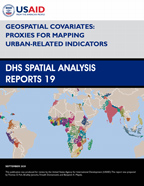- PUBLICATIONS
- JOURNAL ARTICLES
- ACCESS PUBLICATIONS
Publications Summary
- Document Type
- Spatial Analysis Reports
- Publication Topic(s)
- Geographic Information
- Language
- English
- Recommended Citation
- Fish, Thomas D., Bradley Janocha, Trinadh Dontamsetti, and Benjamin K. Mayala. 2020. Predicting Geospatial Covariates: Proxies for Mapping Urban-Related Indicators. DHS Spatial Analysis Reports No. 19. Rockville, Maryland, USA: ICF.
- Download Citation
- RIS format / Text format / Endnote format
- Publication Date
- September 2020
- Publication ID
- SAR19
Download
 Geospatial Covariates: Proxies for Mapping Urban-Related Indicators (PDF, 3281K)
Geospatial Covariates: Proxies for Mapping Urban-Related Indicators (PDF, 3281K)
Download this publication
There is no printed copy available to order.
